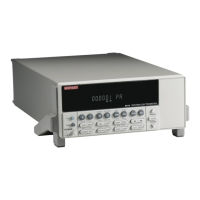Limit Tests 10-7
Digital output patterns
Model 6514 uses digital output bit patterns to communicate test results to the component han-
dler. For each limit test, unique fail patterns are used for the HI and LO limits. A pass pattern is
used to indicate that there were no errors. After a test is finished, the appropriate output pattern
is sent to the component handler. The handler decodes the bit pattern and places the DUT in the
appropriate bin.
Model 6514 can be used with either of the two basic types of handlers. When used with a cat-
egory pulse handler, Model 6514 pulses one of the four handler lines. The handler then places
the DUT into the bin assigned to the pulsed line.
When used with a category register handler, Model 6514 outputs a bit pattern to three handler
lines. After Model 6514 sends the end-of-test (EOT) strobe pulse to the fourth handler line, the
handler places the DUT into the bin assigned to that bit pattern.
Component handler types
Model 6514 can accommodate two different types of component handlers; category pulse,
and category register.
Category pulse component handler
When using this type of handler, Model 6514 pulses one of the four handler lines when a pass
or fail condition occurs. The handler then places the DUT in the bin assigned to that pulsed line.
When interfacing to this type of handler, a maximum of four component handler bins are sup-
ported.
If the handler requires low-going pulses, then the four digital output lines of Model 6514 must
be initially set to high. This initial HI, HI, HI, HI clear pattern on the output lines represents a
“no action” condition for the handler since it is waiting for one of the lines to go low. A line goes
low when the defined fail or pass pattern sets it low. For example, if you want a particular test
failure to pulse line #4 of the handler, the defined fail pattern has to be HI, HI, HI, LO. When the
failure occurs, line #4 will be pulled low, and the DUT will be placed in the bin assigned to that
pulsed line.
If the handler requires a high-going pulse, the four digital output lines of Model 6514 must
initially be set low. The LO, LO, LO, LO clear pattern represents the “no action” condition for
the handler. When one of those lines are pulled high by a defined pass or fail bit pattern (i.e., LO,
LO, LO, HI), the DUT will be placed in the bit assigned to that pulsed line.
Category register component handler
When using this type of handler, Model 6514 sends a bit pattern to three handler lines when
a pass or fail condition occurs. This bit pattern determines the bin assignment for the DUT. With
the pass/fail pattern on the output, line #4 is then pulsed. This EOT (end-of-test) pulse latches
the bit pattern into the register of the handler, which places the DUT in the assigned bin. When
interfacing to this type of handler, a maximum of eight component handler bins are supported.

